Monitor "ECTS" parameter on the Scantool.
Specification : Current enigne coolant temperature is displayed.


Engine Coolant Temperature Sensor(ECTS), installed in coolant line, senses engine coolant temperature.With the information about engine coolant temperature, ECM performs fuel injection quantity correction, cooling fan control and glow relay operating duration control.Especially, because ECTS signal is main variable of fuel injection quantity correction when engine is cold, sensor trouble makes starting engine difficult when engine is cold.If engine is running when ECTS is out of order, ECM regards engine coolant temperature as 80℃. And during cranking, ECM considers engine coolant temperature as -10℃. Besides, cooling fan, which is controlled based on ECTS signal, operates at HIGH-MODE to prevent engine overheat and supplementary heater is deactivated.
P0118 is set when the voltage above 4965mV - maximum output voltage of ECTS - is detected for more than 2.0 sec. This code is due to open or short to battery in signal circuit or open in ground circuit.
Item | Detecting Condition | Possible Cause | ||
DTC Strategy | ● Voltage monitoring | ● ECTS circuit ● ECTS component | ||
Enable Conditions | ● IG KEY "ON" | |||
ThresholdValue | ● Output signal above the maximum value( above 4965mV ) | |||
DiagnosticTime | ● 2.0 sec. | |||
Fail Safe | Fuel Cut | NO | ● A/C condensor fan control operation based on engine coolant temperature inhibited. ● PTC heater inhibited. ● Cooling fan is fixed at HIGH-MODE. ● during engine operation : temperature is fixed at 80℃ at cranking : temperature is fixed at -10℃ | |
EGR Off | YES | |||
Fuel Limit | NO | |||
MIL | NO | |||
Temperature | -40℃ | -20℃ | 0℃ | 20℃ | 40℃ |
Resistance | 48.14㏀ | 15.48±1.35㏀ | 5.790㏀ | 2.45±0.14㏀ | 1.148㏀ |
Temperature | 60℃ | 80℃ | 100℃ | 110℃ | 120℃ |
Resistance | 0.586㏀ | 0.322㏀ | 0.188㏀ | 0.147±0.002㏀ | 0.116㏀ |
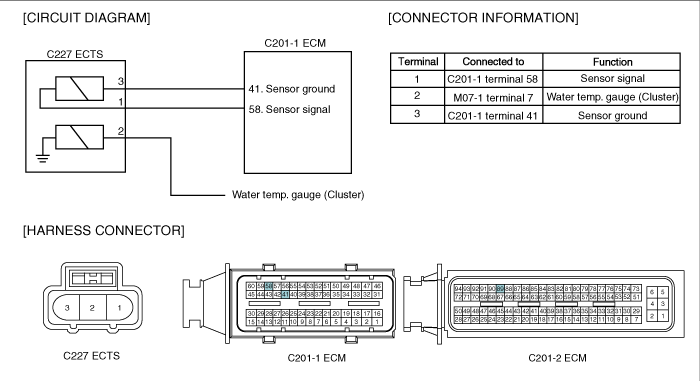
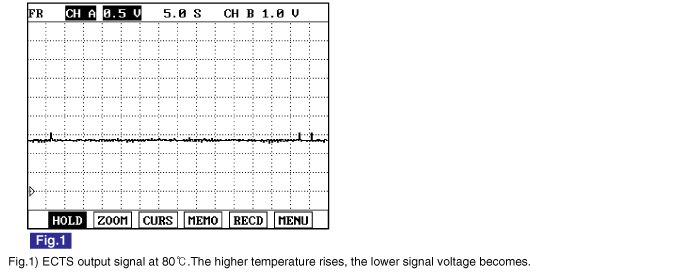
Connect Scantool to Data Link Connector (DLC).
Warm engine up to normal operating temperature.
Turn "OFF" electrical devices and A/C.
Monitor "ECTS" parameter on the Scantool.
Specification : Current enigne coolant temperature is displayed.

Electrical systems consist of a lot of harness and connectors, poor connection of terminals can cause various problems and damge of component.
Perform checking procedure as follows.
Check damage of harness and terminals : Check terminals for contact resistance, corrosion and deformation.
Check connecting condition of ECM and component connector : Check terminal seperation, damage of locking device and connecting condition between terminal and wiring.
Disconnect the pin which requires checking at male connector and insert it to the terminal at female connector for checking connecting condition. ( after checking, reconnect the pin at correct position. )
Is the problem found?

▶ Repair the trouble causing part and go to "Verification of Vehicle Repair".

▶ Go to "Signal Circuit Inspection ".
Check signal circuit voltage
IG KEY "OFF", ENGINE "OFF".
Disconnect ECTS connector.
IG KEY "ON".
Measure the voltage of ECTS connector terminal 1.
Specification : 4.8V~5.1V
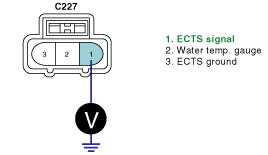
Is the measured voltage within the specification?

▶ Go to "Component Inspection".

▶ Go to "2.Check open in signal circuit" as follows.
Check open in signal circuit
IG KEY "OFF", ENGINE "OFF".
Disconnect ECTS connector and ECM connector.
Check continuity between ECTS connector terminal 1 and ECM connector terminal 58.
Specification : continuity ( below 1.0Ω )
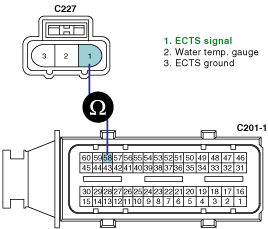
Is the measured resistance within the specification?

▶ Go to "3.Check short to battery in signal circuit" as follows.

▶ Repair open in signal circuit and go to "Verification of Vehicle Repair".
Check short to battery in signal circuit
IG KEY "OFF", ENGINE "OFF".
Disconnect ECTS connector and ECM connector.
IG KEY "ON".
Measure the voltage of ECTS connector terminal 1.
Specification : 0.0V~0.1V

Is the measured voltage within the specification?

▶ Go to "Ground Circuit Inspection".

▶ Repair short to battery in signal circuit and go to "Verification of Vehicle Repair".
IG KEY "OFF", ENGINE "OFF".
Disconnect ECTS connector.
IG KEY "ON".
Measure the voltage of ECTS connector terminal 1. [ TEST "A" ]
Measure the voltage between ECTS connector terminal 1 and 3. [ TEST "B" ]
( terminal 1 : Check + prove , terminal 3 : Check - prove )
Specification : [TEST "A"] Voltage - [TEST "B"] Voltage = below 200mV

Is the measured voltage within the specification?

▶ Go to "Component Inspection".

▶ When "B" voltage is not detected : Repair open in ground circuit and go to "Verification of Vehicle Repair".
▶ When the voltage difference between "A" and "B" is above 200mV : Eliminate the causes of excessive resistance and go to "Verification of Vehicle Repair".
IG KEY "OFF", ENGINE "OFF".
Disconnect ECTS connector.
Measure resistance between ECTS terminal 1 and 3, referring to resistance characteristic table of specification of General information.
Specification : Refer to Specification of General Information
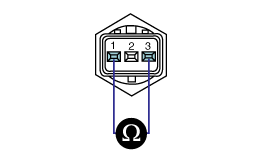
Is the measured resistance at certain temperature within the specified resisance range at the temperature?

▶ Go to "Verification of Vehicle Repair".

▶ Replace ECTS and go to "Verification of Vehicle Repair".
After a repair, it is essential to verify that the fault is corrected.
After connecting Scantool select "DIAGNOSTIC TROUBLE CODES(DTCs)" mode.
Clear recorded DTC using Scantool.
Drive the vehicle within DTC "Enable conditions" in "General information".
After selecting "DIAGNOSTIC TROUBLE CODES(DTCs)" mode and check if DTC is recorded again.
Are any DTCs recorded ?

▶ Go to the DTC guide of recorded NO. in Scantool.

▶ System operates within specification.